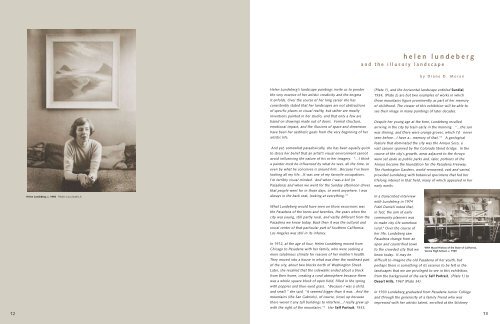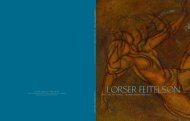helen lundeberg - Louis Stern Fine Arts
helen lundeberg - Louis Stern Fine Arts
helen lundeberg - Louis Stern Fine Arts
You also want an ePaper? Increase the reach of your titles
YUMPU automatically turns print PDFs into web optimized ePapers that Google loves.
Helen Lundeberg, c. 1948 Photo: Lou Jacobs Jr.<br />
Helen Lundeberg’s landscape paintings invite us to ponder<br />
the very essence of her artistic creativity and the enigma<br />
it enfolds. Over the course of her long career she has<br />
consistently stated that her landscapes are not abstractions<br />
of specific places or visual reality, but rather are mostly<br />
inventions painted in her studio, and that only a few are<br />
based on drawings made out of doors. Formal structure,<br />
emotional impact, and the illusions of space and dimension<br />
have been her aesthetic goals from the very beginning of her<br />
artistic life.<br />
And yet, somewhat paradoxically, she has been equally quick<br />
to stress her belief that an artist’s visual environment cannot<br />
avoid influencing the nature of his or her imagery. “…I think<br />
a painter must be influenced by what he sees, all the time, or<br />
even by what he conceives is around him…Because I’ve been<br />
looking all my life…It was one of my favorite occupations.<br />
I’m terribly visual minded. And when I was a kid (in<br />
Pasadena) and when we went for the Sunday afternoon drives<br />
that people went for in those days, or went anywhere, I was<br />
always in the back seat, looking at everything.” 1<br />
What Lundeberg would have seen on those excursions was<br />
the Pasadena of the teens and twenties, the years when the<br />
city was young, still partly rural, and vastly different from the<br />
Pasadena we know today. Back then it was the cultural and<br />
social center of that particular part of Southern California;<br />
Los Angeles was still in its infancy.<br />
In 1912, at the age of four, Helen Lundeberg moved from<br />
Chicago to Pasadena with her family, who were seeking a<br />
more salubrious climate for reasons of her mother’s health.<br />
They moved into a house in what was then the northeast part<br />
of the city, about two blocks north of Washington Street.<br />
Later, she recalled that the sidewalks ended about a block<br />
from their home, creating a rural atmosphere because there<br />
was a whole square block of open field, filled in the spring<br />
with poppies and blue-eyed grass. “Because I was a child,<br />
and small,” she said, “it seemed bigger than it was…And the<br />
mountains (the San Gabriels), of course, (rose) up because<br />
there weren’t any tall buildings to interfere…I really grew up<br />
with the sight of the mountains.” 2 Her Self Portrait, 1933,<br />
<strong>helen</strong> <strong>lundeberg</strong><br />
and the illusory landscape<br />
by Diane D. Moran<br />
(Plate 1), and the horizontal landscape entitled Sundial,<br />
1934, (Plate 2) are but two examples of works in which<br />
those mountains figure prominently as part of her memory<br />
of childhood. The viewer of this exhibition will be able to<br />
see their image in many paintings of later decades.<br />
Despite her young age at the time, Lundeberg recalled<br />
arriving in the city by train early in the morning. “…the sun<br />
was shining, and there were orange groves, which I’d never<br />
seen before…I have a…memory of that.” 3 A geological<br />
feature that dominated the city was the Arroyo Seco, a<br />
vast canyon spanned by the Colorado Street bridge. In the<br />
course of the city’s growth, areas adjacent to the Arroyo<br />
were set aside as public parks and, later, portions of the<br />
Arroyo became the foundation for the Pasadena Freeway.<br />
The Huntington Gardens, world-renowned, vast and varied,<br />
provided Lundeberg with botanical specimens that fed her<br />
lifelong interest in that field, many of which appeared in her<br />
early works.<br />
In a transcribed interview<br />
with Lundeberg in 1974<br />
Fidel Danieli noted that,<br />
in fact, the aim of early<br />
community planners was<br />
to make city life somehow<br />
rural. 4 Over the course of<br />
her life, Lundeberg saw<br />
Pasadena change from an<br />
open and countrified town<br />
to the crowded city that we<br />
know today. It may be<br />
difficult to imagine the old Pasadena of her youth, but<br />
perhaps there is something of its essence to be felt in the<br />
landscapes that we are privileged to see in this exhibition,<br />
from the background of the early Self Portrait, (Plate 1) to<br />
Desert Hills, 1967 (Plate 34).<br />
WPA Mural History of the State of California,<br />
Venice High School, c. 1939<br />
In 1930 Lundeberg graduated from Pasadena Junior College<br />
and through the generosity of a family friend who was<br />
impressed with her artistic talent, enrolled at the Stickney<br />
12 13





